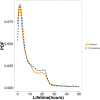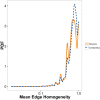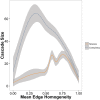The spreading of misinformation online - PubMed (original) (raw)
The spreading of misinformation online
Michela Del Vicario et al. Proc Natl Acad Sci U S A. 2016.
Abstract
The wide availability of user-provided content in online social media facilitates the aggregation of people around common interests, worldviews, and narratives. However, the World Wide Web (WWW) also allows for the rapid dissemination of unsubstantiated rumors and conspiracy theories that often elicit rapid, large, but naive social responses such as the recent case of Jade Helm 15--where a simple military exercise turned out to be perceived as the beginning of a new civil war in the United States. In this work, we address the determinants governing misinformation spreading through a thorough quantitative analysis. In particular, we focus on how Facebook users consume information related to two distinct narratives: scientific and conspiracy news. We find that, although consumers of scientific and conspiracy stories present similar consumption patterns with respect to content, cascade dynamics differ. Selective exposure to content is the primary driver of content diffusion and generates the formation of homogeneous clusters, i.e., "echo chambers." Indeed, homogeneity appears to be the primary driver for the diffusion of contents and each echo chamber has its own cascade dynamics. Finally, we introduce a data-driven percolation model mimicking rumor spreading and we show that homogeneity and polarization are the main determinants for predicting cascades' size.
Keywords: Facebook; cascades; misinformation; rumor spreading; virality.
Conflict of interest statement
The authors declare no conflict of interest.
Figures
Fig. 1.
PDF of lifetime computed on science news and conspiracy theories, where the lifetime is here computed as the temporal distance (in hours) between the first and last share of a post. Both categories show a similar behavior.
Fig. 2.
Lifetime as a function of the cascade size for conspiracy news (Left) and science news (Right). Science news quickly reaches a higher diffusion; a longer lifetime does not correspond to a higher level of interest. Conspiracy rumors are assimilated more slowly and show a positive relation between lifetime and size.
Fig. 3.
PDF of edge homogeneity for science (orange) and conspiracy (blue) news. Homogeneity paths are dominant on the whole cascades for both scientific and conspiracy news.
Fig. 4.
Cascade size as a function of edge homogeneity for science (orange) and conspiracy (dashed blue) news.
Fig. 5.
CCDF of size (Left) and CDF of height (Right) for the best parameters combination that fits real-data values,(ϕHL,r,δ)=(0.56,0.01,0.015), and first sharers distributed as IG(18.73,9.63).
Similar articles
- Science vs conspiracy: collective narratives in the age of misinformation.
Bessi A, Coletto M, Davidescu GA, Scala A, Caldarelli G, Quattrociocchi W. Bessi A, et al. PLoS One. 2015 Feb 23;10(2):e0118093. doi: 10.1371/journal.pone.0118093. eCollection 2015. PLoS One. 2015. PMID: 25706981 Free PMC article. - Emotional Dynamics in the Age of Misinformation.
Zollo F, Novak PK, Del Vicario M, Bessi A, Mozetič I, Scala A, Caldarelli G, Quattrociocchi W. Zollo F, et al. PLoS One. 2015 Sep 30;10(9):e0138740. doi: 10.1371/journal.pone.0138740. eCollection 2015. PLoS One. 2015. PMID: 26422473 Free PMC article. - Trend of Narratives in the Age of Misinformation.
Bessi A, Zollo F, Del Vicario M, Scala A, Caldarelli G, Quattrociocchi W. Bessi A, et al. PLoS One. 2015 Aug 14;10(8):e0134641. doi: 10.1371/journal.pone.0134641. eCollection 2015. PLoS One. 2015. PMID: 26275043 Free PMC article. - Conspiracy theories and social media platforms.
Cinelli M, Etta G, Avalle M, Quattrociocchi A, Di Marco N, Valensise C, Galeazzi A, Quattrociocchi W. Cinelli M, et al. Curr Opin Psychol. 2022 Oct;47:101407. doi: 10.1016/j.copsyc.2022.101407. Epub 2022 Jun 30. Curr Opin Psychol. 2022. PMID: 35868169 Review. - Deep learning for misinformation detection on online social networks: a survey and new perspectives.
Islam MR, Liu S, Wang X, Xu G. Islam MR, et al. Soc Netw Anal Min. 2020;10(1):82. doi: 10.1007/s13278-020-00696-x. Epub 2020 Sep 29. Soc Netw Anal Min. 2020. PMID: 33014173 Free PMC article. Review.
Cited by
- Human trafficking and the growing malady of disinformation.
Prakash J, Erickson TB, Stoklosa H. Prakash J, et al. Front Public Health. 2022 Sep 20;10:987159. doi: 10.3389/fpubh.2022.987159. eCollection 2022. Front Public Health. 2022. PMID: 36203682 Free PMC article. - Mitigating infodemics: The relationship between news exposure and trust and belief in COVID-19 fake news and social media spreading.
Melki J, Tamim H, Hadid D, Makki M, El Amine J, Hitti E. Melki J, et al. PLoS One. 2021 Jun 4;16(6):e0252830. doi: 10.1371/journal.pone.0252830. eCollection 2021. PLoS One. 2021. PMID: 34086813 Free PMC article. - A Multidimensional Approach for Evaluating Reality in Social Media: Mixed Methods Study.
Cho H, Li W, Lopez R. Cho H, et al. J Med Internet Res. 2024 Aug 6;26:e52058. doi: 10.2196/52058. J Med Internet Res. 2024. PMID: 39106092 Free PMC article. - The Role of Conspiracy Theories in the Spread of COVID-19 across the United States.
Gu F, Wu Y, Hu X, Guo J, Yang X, Zhao X. Gu F, et al. Int J Environ Res Public Health. 2021 Apr 6;18(7):3843. doi: 10.3390/ijerph18073843. Int J Environ Res Public Health. 2021. PMID: 33917575 Free PMC article. - Promoting engagement with quality communication in social media.
Cinelli M, Peruzzi A, Schmidt AL, Villa R, Costa E, Quattrociocchi W, Zollo F. Cinelli M, et al. PLoS One. 2022 Oct 13;17(10):e0275534. doi: 10.1371/journal.pone.0275534. eCollection 2022. PLoS One. 2022. PMID: 36227911 Free PMC article.
References
- Brown J, Broderick AJ, Lee N. Word of mouth communication within online communities: Conceptualizing the online social network. J Interact Market. 2007;21(3):2–20.
- Kahn R, Kellner D. New media and internet activism: From the “battle of Seattle” to blogging. New Media Soc. 2004;6(1):87–95.
- Quattrociocchi W, Conte R, Lodi E. Opinions manipulation: Media, power and gossip. Adv Complex Syst. 2011;14(4):567–586.
- Kumar R, Mahdian M, McGlohon M. Proceedings of the 16th ACM SIGKDD International Conference on Knowledge Discovery and Data Mining. ACM; New York: 2010. Dynamics of conversations; pp. 553–562.
Publication types
MeSH terms
LinkOut - more resources
Full Text Sources
Other Literature Sources




